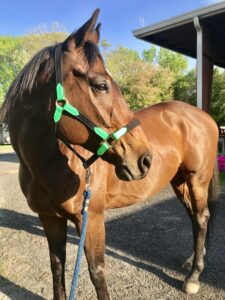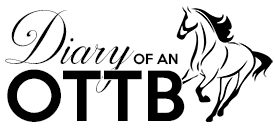Liberty training for horses can be some absolutely magical stuff to watch. If you’ve ever been to a horse expo or seen a training demonstration, there’s a good chance that you know what I’m talking about.
It can look a little something like the video below when it’s really complex, but working at liberty with horses simply refers to training without the use of ropes or other mechanical aids (other than a standard long whip) to elicit a specific movement or set of movements from your horse. Those movements can be as simple as backing up, rearing, or yielding the hind end and it can be as complex as manipulating a whole herd of horses while standing on the back of another one or riding bareback and bridleless.
Check out this awesome liberty demonstration from Double Dan at the Equine Affaire in Springield, MA in 2017.
There are some phenomenal trainers out there who do a lot of liberty training, including Double Dan Horsemanship featured in the video above, Pat Parelli, and Guy McLean, all of whom I’ve seen in demonstrations at large expos in Pennsylvania and Massachusetts. What they can do with a group of well trained horses looks nothing short of magical.
But it’s not magic. It’s training and hours and hours of practice.
How Liberty Training Helps You & Your Horse
Liberty training with horses puts the emphasis on communication and focus between you and your horse. You’ll know almost immediately whether or not your horse is listening to you with this practice and as a result, you’ll be able to work on refocusing their attention back to you.
With literally no strings attached, working at liberty encourages your horse to move more freely in a way that feels a lot more like play than work. Basic lunging exercises that you may have practiced in a round pen, can be used as the very foundation of liberty training. Take this basic exercise and try it with your horse in a large field or open arena. See how responsive (or not responsive) he or she is. When the horse ignores you or runs into a corner, begin to approach them and ask them to move in one direction or the other. This quickly becomes a more enjoyable game of cat and mouse, but with a little persistence and patience, your horse will eventually start looking to your for direction. Freely, at their own choosing.
Liberty training translates in a way that horses are used to communicating through — pressure and release of pressure — but also works on establishing a bond between you and your horse… because you’re essentially speaking the same language and talking to them on their level.
What’s The Difference Between Working at Liberty & On a Line or in a Round pen?
In two weeks of working at liberty with my Thoroughbred, I’ve noticed a few big differences between this and working in a round pen or on a lunge line: it’s more challenging even though it uses the same skills, it’s more fun because you’re essentially playing with your pony, it promotes relaxation during exercise, and it works on building a relationship with your horse that goes beyond work.
The lunge line or round pen are both great, controlled places to start working in. But sometimes they can create a fall sense of security and accomplishment.
Both on a line or even in the round pen, my TB loves to throw himself into pressure and counter-bend around and around. Put him on a lunge line and while he might move in the direction you’re asking, he’ll rarely relax and get to the point where I can isolate that relaxed behavior and reinforce it. While the long line lunging and the round pen are great to begin with, they do the work of dictating the horse’s direction for you. Working at liberty puts every detail of your ability to communicate with your horse under a microscope.
Liberty work in a large open space allows a horse to be him or herself without the physical aids or manipulation of their movement. Instead, it’s on the human to do the leg work to add and remove pressure when your horse has answered the question how you wanted them to. It’s also an excellent practice to go back to when things like proper movement need to be reinforced. Instead of relying on the pressure of ropes or panels of round pen, liberty training in large open areas forces the dialogue between you and your horse while putting you in a position to observe and reward the proper behavior.
Using Liberty Training With My OTTB

I’ve been doing some liberty training and free lunging with my off track Thoroughbred and in a few short weeks you can call me a full-fledged believer in this stuff. My TB is a little on the cold backed side, which means that without a good warm-up he can struggle to engage some of his back and core muscles and act a little less than desirable.
With two weeks of free lunging, he’s shown some tremendous improvement in his posture and his overall demeanor even though we’ve spent the last 8 months practicing on the line and in the round pen. I can’t give all the credit of his progress to liberty work, but I can certainly give it a lot since I’ve seen a huge improvement over such a short period of time and it’s been a big focus of our training in the last few weeks. Now, instead of running around like a giraffe, we’re doing a modest impression of reining horse — neck stretching, back engaged. And better still he’s become more of a gentlemen, whether through sheer exhaustion or actual progress.
Liberty training might require more running around on the part of the human the first couple times but it’s also one of the easier ways to quickly give your horse a full workout. After all, for any amount of running around I’m doing my horse should be doing at least twice as much. Particularly relevant for OTTBs, liberty training has helped me establish a more productive routine with him that’s not only physically challenging but mentally as well.
How to Start Liberty Training With Your Horse
The first goal of any liberty work is two-fold: to be able to control both the front and hind end of the horse and to have your horse focus on you. Some of you may have already practiced yielding the hind quarters or maybe you’ve tried lunging in a round pen. These are all perfect building blocks to start liberty training with. Apply whatever practice you’ve been doing on a line or in a round pen and change the environment but ask the same questions and look for the same right answers.
Horses are prey animals and as a result most of them shy away from pressure based on where that pressure is in relation to their drive line. What’s the drive line you might ask? Excellent question random reader! Check out the diagram below.

The driveline is the point on the horse where the pressure changes direction, giving you control of either their hind end or their front end. If you get in front of this line while you’re lunging, you’ll have the effect of slowing down your horse or turning them around. Get behind this line and you’ll encourage them to move forward. This is the most important aspect to remember and from here you build up.
All of this is explained in much more (and better) detail in the video from Double Dan below where he shares how he gets started with liberty work. You can also ready over this set of connection exercises that can help get you started here.
Liberty work is really for any horseperson at any level because it only requires the understanding of a few basic concepts but can serve as the foundation for building a better bond with your horse. With that in mind, get outside and go play around with your horse. It’s the only way to truly learn!
6

Pingback: Building Topline: Tips for Strengthening Your Horse’s Back – Diary of an OTTB